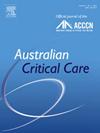Optimising the frequency of routine arterial blood gas testing in the intensive care unit: An observational study
IF 2.7
3区 医学
Q2 CRITICAL CARE MEDICINE
引用次数: 0
Abstract
Background
Arterial blood gas (ABG) testing is a broadly utilised tool in intensive care units (ICUs), though there is an acceptance that an excessive number are performed routinely. Reducing collection frequency has previously demonstrated no impact on benchmarked outcomes. This observational study assessed the impact of reducing routine ABG testing frequency on critical value detection, routine bedside interventions, and patient outcomes.
Objective
The objective of this study was to evaluate the safety and clinical utility of routine ABG collection by reviewing test frequency, critical value detection, bedside interventions (including respiratory support and electrolyte supplementation), and patient outcomes.
Methods
This observational study compared three time periods (preintervention, postintervention, and 1-year follow-up) between 2019 and 2021, following implementation of an ABG testing protocol in February 2020. ABG testing frequency and associated critical values were recorded alongside routine bedside interventions (system support changes).
Setting
The study was conducted in Cairns Hospital ICU, a regional mixed ICU in Australia with approximately 1200 annual admissions.
Participants
Adult patients admitted for over 24 h without an established need for high-frequency ABG collection participated in the study.
Results
ABG use decreased significantly from 4.93 to 3.06 tests per patient per day (p < 0.001), sustained at 1-year follow-up. The proportion of patients with at least one critical value detected did not differ significantly (57% vs. 49%, p = 0.06), though the number of critical values per patient per day declined (3.89 vs. 2.99, p < 0.001). Rates of respiratory support changes—including adjustments in fraction of inspired oxygen, type of respiratory support, and amount of positive end-expiratory pressure—were not significantly reduced. Potassium supplementation remained similar (27.10 mEq/day vs. 26.20 mEq/day, p = 0.288). Mortality was unchanged (6.5% vs. 11.5%, p = 0.074).
Conclusion
Routine ABG analysis is associated with overtesting. A routine ABG collection protocol supported by staff education significantly reduces their collection frequency without compromising day-to-day care or overall patient outcomes.
优化重症监护病房常规动脉血气检测频率:一项观察性研究。
背景:动脉血气(ABG)检测是重症监护病房(icu)中广泛使用的工具,尽管人们普遍认为常规检查的次数过多。以前已经证明减少收集频率对基准结果没有影响。本观察性研究评估了减少常规ABG检测频率对临界值检测、常规床边干预和患者预后的影响。目的:本研究的目的是通过回顾检测频率、临界值检测、床边干预(包括呼吸支持和电解质补充)和患者结局来评估常规ABG采集的安全性和临床实用性。方法:本观察性研究比较了2020年2月实施ABG测试方案后2019年至2021年的三个时间段(干预前、干预后和1年随访)。ABG检测频率和相关临界值与常规床边干预(系统支持改变)一起记录。环境:该研究是在凯恩斯医院ICU进行的,这是澳大利亚的一个区域混合ICU,每年约有1200人入院。参与者:入院超过24小时且没有确定需要高频ABG采集的成年患者参与了这项研究。结果:ABG使用显著下降,从4.93降至3.06例/患者/天(p < 0.001),持续1年随访。检测到至少一个临界值的患者比例没有显著差异(57%对49%,p = 0.06),尽管每位患者每天检测到的临界值数量有所下降(3.89对2.99,p < 0.001)。呼吸支持改变的比率——包括吸入氧气的比例、呼吸支持类型和呼气末正压的量的调整——没有显著降低。钾补充量保持相似(27.10 mEq/天vs. 26.20 mEq/天,p = 0.288)。死亡率没有变化(6.5% vs. 11.5%, p = 0.074)。结论:常规ABG分析与过度检测有关。在员工教育的支持下,常规血气收集方案显著减少了他们的收集频率,而不会影响日常护理或患者的总体结果。
本文章由计算机程序翻译,如有差异,请以英文原文为准。
求助全文
约1分钟内获得全文
求助全文
来源期刊

Australian Critical Care
NURSING-NURSING
CiteScore
4.90
自引率
9.10%
发文量
148
审稿时长
>12 weeks
期刊介绍:
Australian Critical Care is the official journal of the Australian College of Critical Care Nurses (ACCCN). It is a bi-monthly peer-reviewed journal, providing clinically relevant research, reviews and articles of interest to the critical care community. Australian Critical Care publishes peer-reviewed scholarly papers that report research findings, research-based reviews, discussion papers and commentaries which are of interest to an international readership of critical care practitioners, educators, administrators and researchers. Interprofessional articles are welcomed.
 求助内容:
求助内容: 应助结果提醒方式:
应助结果提醒方式:


